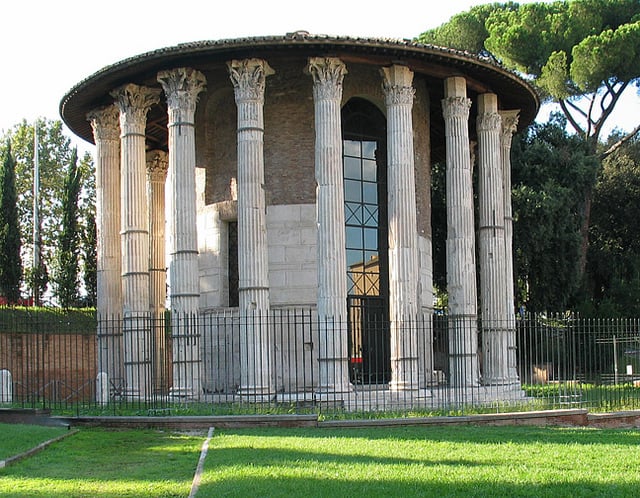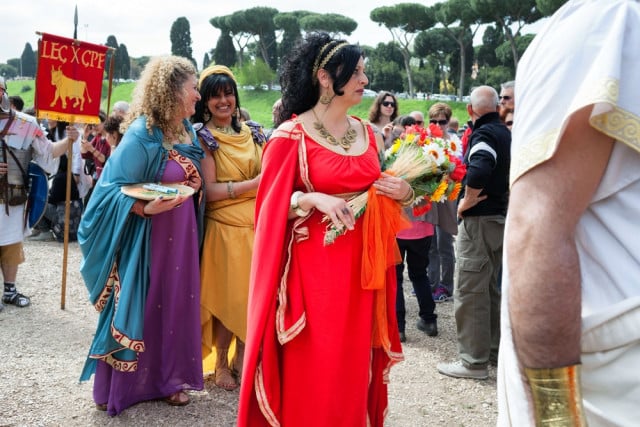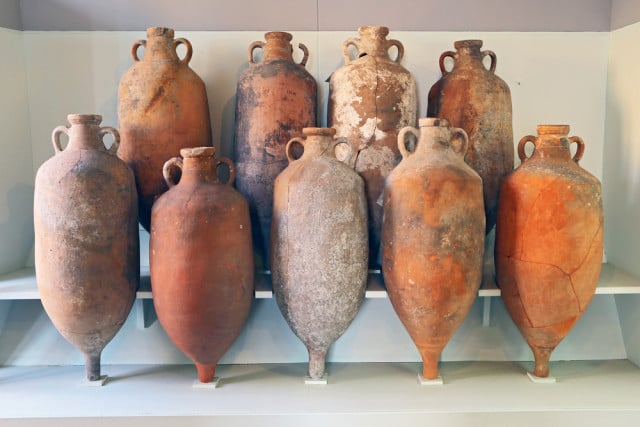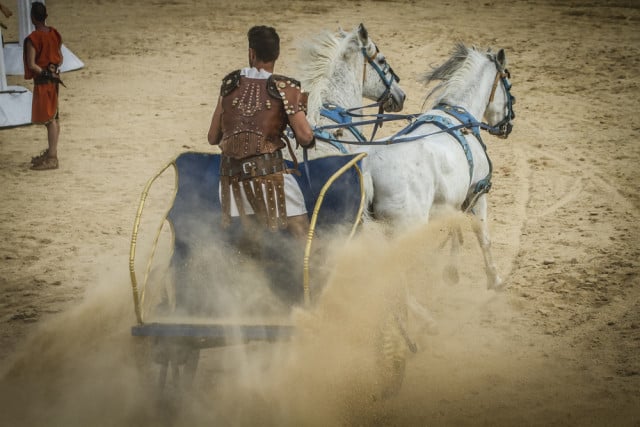8 things you probably didn’t know about the Romans

However much you think you know about the ancient Romans, they're always capable of throwing up a new surprise or two from beyond the grave.
Here are eight facts you probably didn't know about them:
1. They engaged in human sacrifice
This was strictly restricted to Rome’s Regal period, circa 753-509 BC, and Republican period, 509-44 BC. Later Romans made a show of being appalled by the idea of human sacrifice and it was outlawed by senatorial decree in 97 BC. But according to the historians Livy and Plutarch, ritual killings to propitiate the gods were performed on at least three occasions in the years 228, 216, and 113 BC.
In each instance, two pairs of Greeks and Gauls, each consisting of one man and one woman, were buried alive at the Forum Boarium cattle market by the River Tiber, where the Temple of Hercules Victor and the Temple of Portunus stand today.
Vestal virgin priestesses were also buried alive if it was discovered they had broken their vows of chastity, or simply to placate the gods if bad omens started appearing.

The Temple of Hercules Victor in the Forum Boarium. Photo: Roger Ulrich/Flickr
2. They were plagued by malaria
By the time it reached its peak in the second century AD, Rome was probably already a malarial city. It’s unclear exactly how the disease arrived in ancient Rome – most likely it was carried either in the bodies of infected merchants or in mosquito larvae transported in cargo ships from southern trading partners – but the city’s swampy valleys and river banks created the ideal conditions for malarial mosquito populations to thrive. The persistent scourge of malaria, which periodically wiped out large swathes of its citizens, is viewed by some historians as a decisive factor in the fall of the Roman empire.
Epidemics of the disease, as well as other common ailments like smallpox, measles, tuberculosis, and mumps, to which young children were particularly susceptible, brought the Romans’ mean life expectancy down to about 25-30 years. This doesn’t mean Rome had no elderly residents, though: if you remove from the equation the half of all Romans who didn’t make it past the age of 10, those who did survive childhood (and weren’t sent to war or worked to death) stood a decent chance of making it to 65.
READ ALSO: Mythbusting Ancient Rome - did all roads actually lead there?
3. They were mostly immigrants
The tendency of Rome’s inhabitants to succumb to deadly epidemics every few years meant there was only one way to reliably shore up its continuously-depleting population and defend its title as the world’s largest metropolis: immigration. Much like modern-day London and New York, ancient Rome was filled with foreigners from far-flung parts of the world.
Many of these were slaves brought over as part of the plunder from overseas military campaigns, most of whom were eventually freed by (and sometimes later married) their masters and, if male, made Roman citizens. Plenty of others, however, arrived of their own volition to seek their fortunes in the ancient land of opportunity.
Gravestones on display in the city’s museums and along the ancient Appian Way commemorate friends and relatives from territories stretching from modern-day Palestine and Syria to Turkey, Vienna, Germany, Spain, and North Africa, among other places. It didn’t take long before the entire population had some immigrant DNA in their genes.

Participants at the Birth of Rome festival in 2015. Photo: shopartgallery/Depositphotos
4. They lived in high-rise apartment blocks
Housing a population of one million within the confines of Rome’s city walls was no mean feat, but the Romans rose to the challenge by doing what any modern city planner would do today: they built upwards, with brick and mortar, building structures as high as seven stories tall. The street-level ground floors were generally given over to shops and eateries, and the floors above served as living quarters. Each successive apartment complex got more cramped and less desirable the higher you went as your chances of dying in a fire increased; the poorest lived in slum-like conditions on the very top floors.
Few of these insulae (literally: “islands” in Latin) survive today, but in central Rome keen-eyed observers can view the unimposing five-story remains of one such apartment block tucked away by the side of a road which connects the Capitoline hill with the Vittorio Emanuele unification monument.
READ ALSO: It's Rome's birthday: 17 facts about the Eternal City
5. They imported many of their essential goods
It didn’t take long in the course of Rome’s development for the dietary demands of its populace to outstrip the ability of local food producers to meet their needs. Although international trade went both ways and Rome exported some goods of its own, the city was heavily dependent on imports to sustain its inhabitants.
Most significantly, most of the grain used to make the bread on which its citizens subsisted was imported from Carthage (modern-day Tunisia), Sardinia, Sicily, Libya, and Egypt to the Roman port city of Ostia. Markings found on fragments of the hill-sized pile of broken amphorae that form a 2,000-year-old rubbish dump in Rome’s Testaccio neighbourhood also show that the city was at one time sourcing almost all of its olive oil, needed for both cooking and lighting, from Spain and North Africa.
This reliance on imports backfired spectacularly on the city in 409 AD, when Ostia was captured by Alaric the Goth, cutting off Rome’s food supply and leaving its inhabitants to slowly starve.

Ancient Roman amphora, in which olive oil and wine was transported. Photo: trotalo/Depositphotos
6. They polluted on a global scale
Millennia before Europe’s industrial revolution, the expansion of the Roman empire made atmospheric ripples that reached all the way to the Arctic. By drilling 400-500 metres down into arctic ice sheets in Greenland, scientists at Utrecht University have been able to analyse the contents of tiny 2,000-year-old air bubbles which show the composition of the world’s atmosphere in Roman times.
Their findings surprised them: around the time of the 1st century AD they found a sharp spike in methane levels in the gas, caused by a massive increase in burning – a byproduct of the Roman empire’s industrial expansion that is unmatched by anything seen for the following 1,000 years.
READ ALSO: Four civilizations in Italy that pre-date the Roman Empire
7. They had traffic problems
You might not think you’d have much in common with a resident of ancient Rome, but if there’s one aspect of life over which you could share a gripe, it would probably be traffic noise and congestion. Most streets were so narrow they only had room to accommodate one chariot at a time, but no one-way road system was ever implemented. Wealthy Romans sent servants to run to the end of the street and block off oncoming traffic, but when that didn’t happen it was easy for vehicles to meet and get stuck halfway down, and frequent clashes would ensue.
It got so bad in Julius Caesar’s day that he outlawed the use of private vehicles on the city’s streets for the first 10 of its 12 hours of daylight, although exceptions were made for priests and generals. It didn’t do much to appease the city’s residents, though, who complained that they were kept awake throughout the night by the constant clatter of horses’ hooves. Later the Emperor Hadrian banned all horse-riding within the city limits, but the rule seems to have been only loosely observed as Marcus Aurelius had to reissue the same mandate not long after.

A Roman-style chariot. Photo: outsiderzone/Depositphotos
8. They built the world’s most durable sewer
When it comes to feats of engineering, Rome’s most celebrated legacy is its aqueducts. But credit should also go to the city’s Cloaca Maxima (Great Sewer), which was so sturdily constructed and enlarged upon between the 6th century BC and 1st century AD that it was capable of serving as Rome’s sole sewage system on a near-uninterrupted basis until the 19th century, and is still in limited use today.
The Cloaca Maxima’s tunnels were so large you could sail a boat down them, and they performed a dual purpose: as well as channelling effluence away from the city, they were used to symbolically flush out other undesirable elements, including convicted criminals, Christian martyrs, and overthrown tyrants. The bodies of both the disgraced emperor Elagabalus and Saint Sebastian were dragged through the sewer and thrown outside the city in 222 AD and 288 AD respectively.
READ ALSO:
-
Why the average ancient Roman worker was dead by 30
-
Thank the ancient Romans for 'street food'
-
Restored Pompeii kitchens show how Romans cooked
Liked this and want to learn more? We first learned about these facts from Mary Beard’s 2012 BBC series Meet the Romans and 2016 series Ultimate Rome: Empire Without Limit; Simon Sebag Montefiore’s 2012 BBC series Rome: a History of the Eternal City; and Matthew Kneale’s book Rome: A History in Seven Sackings, all of which are a great introduction to life in Ancient Rome.
Comments
See Also
Here are eight facts you probably didn't know about them:
1. They engaged in human sacrifice
This was strictly restricted to Rome’s Regal period, circa 753-509 BC, and Republican period, 509-44 BC. Later Romans made a show of being appalled by the idea of human sacrifice and it was outlawed by senatorial decree in 97 BC. But according to the historians Livy and Plutarch, ritual killings to propitiate the gods were performed on at least three occasions in the years 228, 216, and 113 BC.
In each instance, two pairs of Greeks and Gauls, each consisting of one man and one woman, were buried alive at the Forum Boarium cattle market by the River Tiber, where the Temple of Hercules Victor and the Temple of Portunus stand today.
Vestal virgin priestesses were also buried alive if it was discovered they had broken their vows of chastity, or simply to placate the gods if bad omens started appearing.

The Temple of Hercules Victor in the Forum Boarium. Photo: Roger Ulrich/Flickr
2. They were plagued by malaria
By the time it reached its peak in the second century AD, Rome was probably already a malarial city. It’s unclear exactly how the disease arrived in ancient Rome – most likely it was carried either in the bodies of infected merchants or in mosquito larvae transported in cargo ships from southern trading partners – but the city’s swampy valleys and river banks created the ideal conditions for malarial mosquito populations to thrive. The persistent scourge of malaria, which periodically wiped out large swathes of its citizens, is viewed by some historians as a decisive factor in the fall of the Roman empire.
Epidemics of the disease, as well as other common ailments like smallpox, measles, tuberculosis, and mumps, to which young children were particularly susceptible, brought the Romans’ mean life expectancy down to about 25-30 years. This doesn’t mean Rome had no elderly residents, though: if you remove from the equation the half of all Romans who didn’t make it past the age of 10, those who did survive childhood (and weren’t sent to war or worked to death) stood a decent chance of making it to 65.
READ ALSO: Mythbusting Ancient Rome - did all roads actually lead there?
3. They were mostly immigrants
The tendency of Rome’s inhabitants to succumb to deadly epidemics every few years meant there was only one way to reliably shore up its continuously-depleting population and defend its title as the world’s largest metropolis: immigration. Much like modern-day London and New York, ancient Rome was filled with foreigners from far-flung parts of the world.
Many of these were slaves brought over as part of the plunder from overseas military campaigns, most of whom were eventually freed by (and sometimes later married) their masters and, if male, made Roman citizens. Plenty of others, however, arrived of their own volition to seek their fortunes in the ancient land of opportunity.
Gravestones on display in the city’s museums and along the ancient Appian Way commemorate friends and relatives from territories stretching from modern-day Palestine and Syria to Turkey, Vienna, Germany, Spain, and North Africa, among other places. It didn’t take long before the entire population had some immigrant DNA in their genes.

Participants at the Birth of Rome festival in 2015. Photo: shopartgallery/Depositphotos
4. They lived in high-rise apartment blocks
Housing a population of one million within the confines of Rome’s city walls was no mean feat, but the Romans rose to the challenge by doing what any modern city planner would do today: they built upwards, with brick and mortar, building structures as high as seven stories tall. The street-level ground floors were generally given over to shops and eateries, and the floors above served as living quarters. Each successive apartment complex got more cramped and less desirable the higher you went as your chances of dying in a fire increased; the poorest lived in slum-like conditions on the very top floors.
Few of these insulae (literally: “islands” in Latin) survive today, but in central Rome keen-eyed observers can view the unimposing five-story remains of one such apartment block tucked away by the side of a road which connects the Capitoline hill with the Vittorio Emanuele unification monument.
READ ALSO: It's Rome's birthday: 17 facts about the Eternal City
5. They imported many of their essential goods
It didn’t take long in the course of Rome’s development for the dietary demands of its populace to outstrip the ability of local food producers to meet their needs. Although international trade went both ways and Rome exported some goods of its own, the city was heavily dependent on imports to sustain its inhabitants.
Most significantly, most of the grain used to make the bread on which its citizens subsisted was imported from Carthage (modern-day Tunisia), Sardinia, Sicily, Libya, and Egypt to the Roman port city of Ostia. Markings found on fragments of the hill-sized pile of broken amphorae that form a 2,000-year-old rubbish dump in Rome’s Testaccio neighbourhood also show that the city was at one time sourcing almost all of its olive oil, needed for both cooking and lighting, from Spain and North Africa.
This reliance on imports backfired spectacularly on the city in 409 AD, when Ostia was captured by Alaric the Goth, cutting off Rome’s food supply and leaving its inhabitants to slowly starve.

Ancient Roman amphora, in which olive oil and wine was transported. Photo: trotalo/Depositphotos
6. They polluted on a global scale
Millennia before Europe’s industrial revolution, the expansion of the Roman empire made atmospheric ripples that reached all the way to the Arctic. By drilling 400-500 metres down into arctic ice sheets in Greenland, scientists at Utrecht University have been able to analyse the contents of tiny 2,000-year-old air bubbles which show the composition of the world’s atmosphere in Roman times.
Their findings surprised them: around the time of the 1st century AD they found a sharp spike in methane levels in the gas, caused by a massive increase in burning – a byproduct of the Roman empire’s industrial expansion that is unmatched by anything seen for the following 1,000 years.
READ ALSO: Four civilizations in Italy that pre-date the Roman Empire
7. They had traffic problems
You might not think you’d have much in common with a resident of ancient Rome, but if there’s one aspect of life over which you could share a gripe, it would probably be traffic noise and congestion. Most streets were so narrow they only had room to accommodate one chariot at a time, but no one-way road system was ever implemented. Wealthy Romans sent servants to run to the end of the street and block off oncoming traffic, but when that didn’t happen it was easy for vehicles to meet and get stuck halfway down, and frequent clashes would ensue.
It got so bad in Julius Caesar’s day that he outlawed the use of private vehicles on the city’s streets for the first 10 of its 12 hours of daylight, although exceptions were made for priests and generals. It didn’t do much to appease the city’s residents, though, who complained that they were kept awake throughout the night by the constant clatter of horses’ hooves. Later the Emperor Hadrian banned all horse-riding within the city limits, but the rule seems to have been only loosely observed as Marcus Aurelius had to reissue the same mandate not long after.

A Roman-style chariot. Photo: outsiderzone/Depositphotos
8. They built the world’s most durable sewer
When it comes to feats of engineering, Rome’s most celebrated legacy is its aqueducts. But credit should also go to the city’s Cloaca Maxima (Great Sewer), which was so sturdily constructed and enlarged upon between the 6th century BC and 1st century AD that it was capable of serving as Rome’s sole sewage system on a near-uninterrupted basis until the 19th century, and is still in limited use today.
The Cloaca Maxima’s tunnels were so large you could sail a boat down them, and they performed a dual purpose: as well as channelling effluence away from the city, they were used to symbolically flush out other undesirable elements, including convicted criminals, Christian martyrs, and overthrown tyrants. The bodies of both the disgraced emperor Elagabalus and Saint Sebastian were dragged through the sewer and thrown outside the city in 222 AD and 288 AD respectively.
READ ALSO:
- Why the average ancient Roman worker was dead by 30
- Thank the ancient Romans for 'street food'
- Restored Pompeii kitchens show how Romans cooked
Liked this and want to learn more? We first learned about these facts from Mary Beard’s 2012 BBC series Meet the Romans and 2016 series Ultimate Rome: Empire Without Limit; Simon Sebag Montefiore’s 2012 BBC series Rome: a History of the Eternal City; and Matthew Kneale’s book Rome: A History in Seven Sackings, all of which are a great introduction to life in Ancient Rome.
Join the conversation in our comments section below. Share your own views and experience and if you have a question or suggestion for our journalists then email us at [email protected].
Please keep comments civil, constructive and on topic – and make sure to read our terms of use before getting involved.
Please log in here to leave a comment.